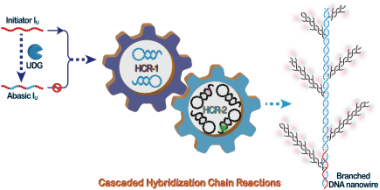Jing Wang, Min Pan, Jie Wei, Xiaoqing Liu and Fuan Wang*
Key Laboratory of Analytical Chemistry for Biology and Medicine (Ministry of Education), College of Chemistry and Molecular Sciences, Wuhan University, Wuhan, Hubei 430072, P. R. China
Chem. Commun., 2017, 53 (96), 12878
DOI: 10.1039/C7CC07057H
First published: 10 October 2017
Abstract

We have successfully engineered a nonenzymatic amplification system based on two-layered cascaded hybridization chain reaction, in which the numerous tandem output triggers of upstream HCR-1 activate downstream HCR-2 to induce successive repeated hybridizations, generating a branched DNA nanostructure that enables the amplified fluorescence readout. The encoded uracil bases of initiator DNA could be cleaved and removed by uracil-DNA glycosylase (UDG), resulting in base deletion of the initiator DNA that is incapable of initiating the isothermal C-HCR process and thus prohibits the subsequent Förster resonance energy transfer generation. The synergistic effect of the two successive HCRs dominates the ultrasensitive detection of UDG and efficient screening of UDG inhibitors. Furthermore, the proposed isothermal C-HCR can be rationally and modularly designed as an avalanche-analogy amplifier that can thus be easily adapted for probing other different biotransformations. The infinite layer of multi-layered C-HCR is anticipated to further strengthen its amplification capacity and to dramatically enhance its anti-invasion performance (reliability) for accurate detecting other clinically important biomarkers. Therefore, the C-HCR strategy provides an adaptive and versatile toolbox for clinical diagnoses and anticancer drug discovery, and thus holds great promise for cancerous treatment and biomedical research.
Full text:http://pubs.rsc.org/-/content/articlehtml/2017/cc/c7cc07057h
